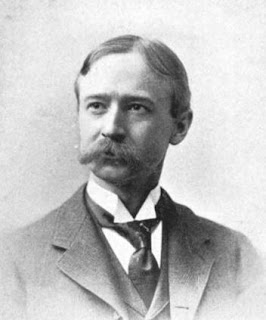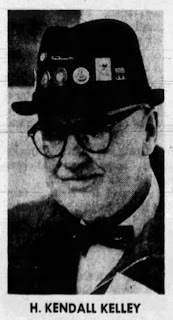One of the most interesting 'behind the scenes' footnotes of the 1971 World Championships involved a Quebec man named Robert Bonin. When the CFSA developed the Quebec section, he had become its first Chairman and in 1971, he was in his final year of office. Bonin travelled to Lyon and set up meetings with Antoine Faure of the FFSG in hopes - he said - of developing "an exchange between ourselves and France, so that either skaters or professionals would crisscross the ocean and... benefit." John McKay, who was the CFSA Vice-President at the time, was one of many who believed that Bonin had ulterior motives for the trip. He later asserted that Bonin "wanted to start a Quebec federation. He went to France to the World Championships in 1971 with the idea of negotiating with the French as a representative of Quebec. It was more than a simple exchange." Bonin's move to break away from the CFSA ultimately failed and the 'exchange program' never happened.
With Tim Wood and Gaby Seyfert not returning to defend their World titles, two of the four gold medals in Lyon were ripe for the picking. With over twenty entries in both singles events, healthy competition was certainly expected. Many expected Irina Rodnina and Alexei Ulanov to defend their pairs title but the competition that defending ice dance champions Lyudmila Pakhomova and Alexander Gorshkov faced was formidable. Let's take a look back at how things played out in Lyon in 1971!
More than a few mâchoires - that's French for jaws - were on the floor when defending World Champions Irina Rodnina and Alexei Ulanov made several uncharacteristic errors in their compulsory short program. Surprisingly, they were still awarded marks for high enough for second place behind their Soviet teammates Lyudmila Smirnova and Andrei Suraikin.
Canada's lone entry, Sandra and Val Bezic, placed ninth in their second trip to the World Championships. Sandra recalled the Lyon Worlds in 1971 thusly: "A fabulous Worlds with all the French touches. We loved the stadium. The seats went straight up coliseum style so the audience felt so close, yet the surface was huge with no boards - only flower pots. The ice was supposedly made with distilled water and it was the fastest ice we'd ever skated on - jumps and toe lifts popped up so easily. The French audience was packed and loud – fabulous. In the pairs event, they fell in love with JoJo Starbuck... whenever she skated the guys in the audience would howl 'JOOOOO JOOOOO!' like a mating call! We skated well and cracked the top ten. I roomed with Louise Soper (gorgeous no matter what time of day!) at the Hotel Terminus. We had a fireplace in our room. The hotel had fabulous gourmet cuisine - and a fabulous bar that served the best croque monsieurs. I remember sitting at the bar counter one day with my competitor, Willy Bietak. After our event I hung out with Vera Wang - Patrick Péra's girlfriend at the time - and others, at the American's hotel. Teams were in separate hotels scattered around the city. Cathy Lee Irwin taught me how to put on make-up for the banquet... techniques I use to this day! Toller and Val roomed together and I roamed the streets with Toller going through antique shops."
THE ICE DANCE COMPETITION
The practice sessions in Lyon were jam packed with ice dance fans, eager to watch all twenty teams choctaw their way through the challenging compulsories that lied ahead. Though France's Anne-Claude Wolfers and Roland Mars weren't major contenders, they received enthusiastic applause from the French crowd at every turn.
Pakhomova and Gorshkov ditched the Tango and Paso Doble free dance that had won them the European title in Zürich and wowed the French crowd with a brand new program set to Russian music. Their program contrasted greatly with the Buck's free dance to selections from "Manuel and The Music of the Mountains" and "Swiss Polka" by Bert Kaempfert. Pakhomova pulled her partner along to receive marks ranging from 5.6 to 5.9. French judge Lysiane Lauret switched alliances and voted with the Eastern Bloc for Pakhomova and Gorshkov.
Sue and Roy Bradshaw, students of Joan Slater, skated superbly to "Oye Negra", "Hernando's Hideaway", "S'Agapo" and "Millionaire's Hoedown" but were unable to crack the top three. All of the remaining positions in the top ten were occupied by teams from the Soviet Union, Great Britain and the United States, with Canada's lone entry, Louise (Lind) and Barry Soper, placing eleventh.
THE WOMEN'S COMPETITION
At the 1969 and 1970 World Championships, Gaby Seyfert had finished second to Austria's Trixi Schuba but won the free skate and the overall title. Schuba, a virtuoso in school figures, again amassed a monstrous lead in the first phase of the competition. The two strongest free skaters, Canadian Karen Magnussen and American Janet Lynn, sat in fourth and fifth place after the figures, behind Julie Lynn Holmes and Rita Trapanese. An especially poor showing in the paragraph double three played a big part in Lynn's result. That margin all but sealed the deal for Schuba to succeed Seyfert as World Champion long before the first of the twenty-two competitors took the ice to perform their free skate.
East Germany's Sonja Morgenstern set a high bar, landing a rare triple Salchow in her free skating performance. However, a ninth place finish in the figures kept her out of the running for a medal. She ended the competition in sixth place.
A report that appeared in "Skating" magazine following the competition recalled the women's free skating performances thusly: "Often underrated for her free skating, [Schuba's] main problem continues to be her appearance, although her recent efforts toward improvement in costume and hair style have been worthwile. Miss Schuba produces a solid program with a good sense of musical feeling, although the total effect is rather uninspiring. Executing two clean double Lutzes, she then slipped on a double loop, but recovered to perform a successful Axel and double flip... Miss [Julie Lynn] Holmes evidenced some problems with her Axels, slipping on the first double and omitting the second entirely. Her inside Axel also had a slight slip, and on yet another Axel toward the end of her program, she almost fell... Some of her freedom of presentation seemed at least temporarily lost. [Magnussen's] two reverse spread eagles into an Axel and a double loop went off beautifully. Known for her consistency, Karen made no terribly obvious errors other than a slip on a double Lutz and a wild free leg on a double Axel. Her other double Axel was excellently performed as were later moves of an Ina Bauer into a spin and an Ina Bauer into a sit spin... The audience had almost as much 'fun' as [Janet] Lynn did, responding in particular to her combination of four consecutive jumps followed by elaborate footwork... Her smooth, exquisite style was in full bloom this spring. Janet's efforts were rewarded by two perfect 6.0's, which left her with high hopes for a medal." Lynn opted to omit a planned triple toe-loop in favour of a double Lutz.
Though Janet Lynn won the free skate in Lyon, all but Soviet judge Nonna Nestegina (who placed Karen Magnussen first) gave their overall first place ordinals to Schuba, who was only seventh in the free skate. Holmes, fifth in the free skate, held on to claim the silver on the strength of her showing in the figures. Magnussen outranked Lynn for the bronze with a majority of first and second place ordinals, while Trapanese settled for fifth place. Canada's other two entries, Diane Hall and Ruth Hutchinson, finished sixteenth and nineteenth.
Canadian writers viewed the situation following Lynn's loss in Janet Lyon a little differently. In his book "The Golden Age Of Canadian Figure Skating" David Young asserted, "The producers of ABC television twisted the facts to suit their own purposes, and perpetrated a fraud on the American viewers. As the crowd applauded for the three medallists, the television camera focused on another unauthorized podium where Janet Lynn, who had finished fourth, was standing. The announcer explained that Janet had completely won the hearts of the French audience, and that all the applause was for her. Trixi, in what should have been the moment of her greatest triumph after years of hard and heart-breaking work, had to be consoled instead by the two other winners. It was a blatant example of the media moulding an event to suit the image which suited it best, and a great many people were extremely upset by the incident, including the U.S. team manager Charles DeMore, who later apologized for the whole thing although he had nothing to do with it." In her book "Peace And Love", Janet Lynn recalled that the whole situation in Lyon was "very embarrassing."
The evening after the women's free skate, there were two separate victory parties going on. Karen Magnussen went across the hall to the room where the Austrians were, grabbed Trixi Schuba by the hand and brought her in to the Canadian room. She announced, "Now I'd like you all to applaud the real world champion."
Patrick Péra was France's best hope for a gold medal at the 1971 World Championships in Lyon. An Olympic, World and European Medallist, Péra was hyped significantly by the French press prior to the competition despite finishing off the podium at the previous year's World Championships in Ljubljana and missing the European Championships in Zürich with a slashed foot.
Toller Cranston, hampered by a disappointing finish in the figures, was only able to move up eleventh. Recalling the event in his book "Zero Tollerance", Cranston said, "I placed fifteenth in the figures, near the bottom of the barrel, below all the people I had beaten weeks earlier. I told Ellen [Burka], 'I just won't be able to skate the long program. I'm too ashamed.' Nevertheless, when the music started, my mind said no but my legs said yes, I skated a dazzling long program and got high marks right off the top, the third skater out. I took sixth place in the free skating but should have won it. Ellen and I thought we'd forget about skating, go to Morocco, and smoke hashish, but reason prevailed."
Three places behind him, skating in his first World Championships, was John Curry. It wasn't the World debut that the young Briton wanted. He had spent the weeks preceding the event training in Davos, spending more time on the ski hills than on patch sessions. By the time he arrived in Lyon, he wasn't even speaking to his coach Arnold Gerschwiler. He placed an unlucky thirteenth in both the figures and free skate and one judge had him as low as sixteenth overall. After his disappointing free skate, he left the ice by a side-entrance to avoid his coach. A few weeks after returning to England, he and Gerschwiler parted ways.
Skate Guard is a blog dedicated to preserving the rich, colourful and fascinating history of figure skating. Over ten years, the blog has featured over a thousand free articles covering all aspects of the sport's history, as well as four compelling in-depth features. To read the latest articles, follow the blog on Facebook, Twitter, Pinterest and YouTube. If you enjoy Skate Guard, please show your support for this archive by ordering a copy of the figure skating reference books "The Almanac of Canadian Figure Skating", "Technical Merit: A History of Figure Skating Jumps" and "A Bibliography of Figure Skating": https://skateguard1.blogspot.com/p/buy-book.html.





























































